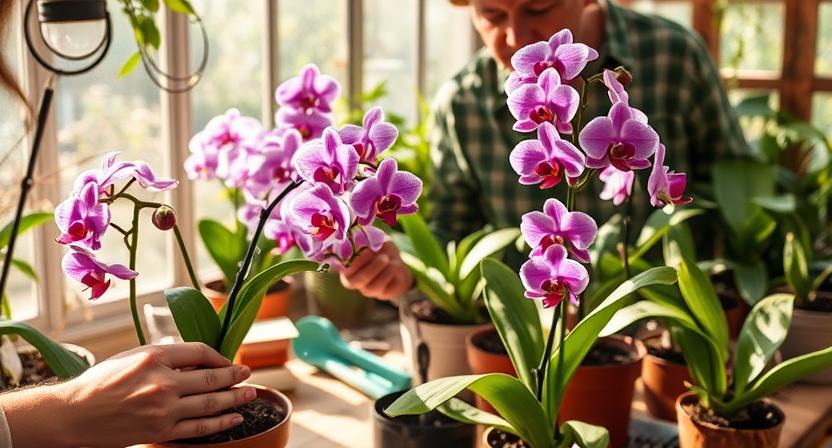Cattleya Orchid Hybrid: Stunning Innovation in Bloom
The cattleya orchid hybrid is a remarkable illustration of how hybrid technology combines science, accuracy, and beauty in the field of botanical hybridisation. Plant breeding has adopted cutting-edge methods to improve characteristics, longevity, and adaptability as hybrid technology continues to expand across a variety of industries, from agriculture to autos. In addition to being a horticultural trend, the creation of cattleya orchid hybrids is a technological achievement combining genetics, cultivation techniques, and biodiversity researc
Cattleya Orchid Hybrid in Modern Hybrid Technology
The cattleya orchid hybrid is a remarkable illustration of how hybrid technology combines science, accuracy, and beauty in the field of botanical hybridisation. Plant breeding has adopted cutting-edge methods to improve characteristics, longevity, and adaptability as hybrid technology continues to expand across a variety of industries, from agriculture to autos. In addition to being a horticultural trend, the creation of cattleya orchid hybrids is a technological achievement combining genetics, cultivation techniques, and biodiversity research.

Genetic Engineering and the Cattleya Orchid Hybrid
To achieve consistency in features, genetic manipulation is a key component of hybrid technology. Although cattleya orchid hybrids are produced naturally by cross-breeding, only the best genetic results are reproduced thanks to sophisticated tissue culture and gene selection techniques. This produces hybrids that are more viable for commercial production in addition to being more aesthetically pleasing.
Why the Cattleya Orchid Hybrid Is Favored by Breeders
The cattleya orchid hybrid is given preference by breeders because of its receptivity to hybridisation and potential for variety. In addition to their already vivid, enormous flowers, Cattleya species can produce hybrids with improved petal texture, longer bloom cycles, and greater endurance in a variety of conditions by crossing with other orchid species like Laelia or Brassavola.
Market Demand Drives Innovation
The demand for cattleya orchid hybrids has increased in both domestic and foreign markets because to consumer interest in unusual, exotic flowers. In order to satisfy this growing demand, the ornamental plant business is utilising data-driven selection methods and hybrid technology concepts that are comparable to those seen in other biotech sectors.
Sustainable Cultivation of Cattleya Orchid Hybrid Varieties
Sustainability is one of hybrid technology’s main objectives. Because it uses less chemicals, the cattleya orchid hybrid promotes sustainable horticulture. Numerous hybrids are created especially to withstand common illnesses and pests, which lessens the need for dangerous pesticides. They also frequently flourish in regulated settings, like as greenhouses, which lessens the impact on the environment.
Propagation Techniques in Hybrid Orchid Breeding
Cattleya hybrids are usually propagated by in-vitro culture and meristem cloning. By preventing random mutations and enabling precise genetic replication, these methods guarantee that each generation maintains its distinct characteristics. This is similar to more general uses of hybrid technology in biotechnology, where control and homogeneity are crucial.
Tissue Culture and Scalability
In the production of orchids on a big scale, tissue culture is essential. A single tissue sample can be used to create thousands of identical plants after a superior hybrid has been created. This strategy provides a dependable supply chain for commercial farmers and retailers while also being in line with sustainable technological norms.
Cattleya Orchid Hybrid as a Model for Hybrid Floral Design
The cattleya orchid hybrid’s striking appearance and symbolic significance make it a popular choice for floral designers and artists. It is a flexible element in floral design, bridal arrangements, and luxury décor because of its wide range of colours and structural variation. In this way, hybrid technology expands the creative possibilities of natural materials by providing variety that would be difficult for nature to provide on its own.

Technological Equipment for Growing Orchid Hybrids
In addition to the plant itself, hybrid technology also plays a part in the machinery needed to grow these plants. High-end orchid farms now typically have hydroponic nutrient delivery systems, LED spectrum lights, and automated climate control systems. Cattleya and other hybrid orchids thrive in the optimal conditions created by these instruments.
Preservation of Species Through Hybrid Technology
In addition to the plant itself, hybrid technology also plays a part in the machinery needed to grow these plants. High-end orchid farms now typically have hydroponic nutrient delivery systems, LED spectrum lights, and automated climate control systems. Cattleya and other hybrid orchids thrive in the optimal conditions created by these instruments.
Educational Institutions Using Cattleya Hybrids for Research
Cattleya orchid hybrids are used in genetics and biodiversity research in universities and botanical institutions. Their intricate yet traceable genetic heritage offers researchers and students a great model for comprehending adaptability, mutation, and plant breeding. In this instance, hybrid technology acts as a research gateway in addition to a teaching instrument.
Challenges in Cattleya Orchid Hybrid Development
Even with the achievement, developing the perfect cattleya orchid hybrid still presents difficulties. Future breeding options are limited by the sterility of some hybrids. Unwanted characteristics like weak stems or irregular blooming may be inherited by others. To create a commercially viable plant, the hybridisation process might take years and involves patience, careful selection, and several experiments.
Avoiding Genetic Drift in Hybrid Orchids
Breeders must prevent genetic drift, which can happen over repeated propagation, in cattleya orchid hybrids in order to preserve stability. In order to address this problem, parent plants are routinely re-selected, and DNA mapping is used to guarantee uniformity between generations.
Commercial Impact of Cattleya Orchid Hybrid on Global Markets
International flower markets have been significantly impacted by the cattleya orchid hybrid. These hybrids are now staples in mass-market retail and high-end floriculture, especially in Asia, Europe, and the Americas. Because well-bred hybrids are seen as exceptional and rare, their value keeps increasing.
Export Opportunities and Trade Regulations
Orchid hybrid trade is controlled, as is the case with other live products, to guard biodiversity and stop illicit collecting. In order to guarantee that only ethically grown hybrids reach international markets, countries that export cattleya orchid hybrids are required to abide by international agreements like as CITES (Convention on International Trade in Endangered Species).
The Future of Hybrid Technology in Orchid Breeding
In the future, it is anticipated that hybrid technology in the orchid industry will become more sustainable and data-driven. In the near future, AI and machine learning could help anticipate the best breeding combinations. As breeders test out new gene pools, improve cultivation techniques, and tackle climate-related issues, the cattleya orchid hybrid will keep changing.

Consumer Education and Responsible Buying
Customers are already influencing how hybrid technology will develop in the future. Knowing the importance of cattleya orchid hybrids, including their breeding, maintenance, and the importance of sustainable practices, enables customers to make decisions that promote environmentally responsible growth.




Post Comment